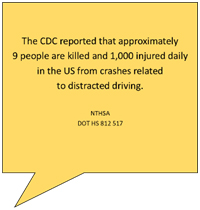Distracted Driving
Once you are underway, falling prey to any distractions puts you and your passengers in danger. Remember, you should always maintain a calm, even tempered attitude while you drive. Becoming easily distracted does not factor into good defensive driving behavior. There is no such thing as, “I only took my eyes off the road for a second.” In that short time, a vehicle, or worse, a small child, can appear in your path without warning.

Simple math reveals that in one second, a car traveling at 30 mph goes over 44 feet.
Before you read a list of common distractions you should always avoid, let’s deal with the big one: cell phones and texting. You need both hands to drive safely. You need at least one hand, many times both, to make a cell phone call or send a text message. Something doesn’t seem right, does it? Using a smart phone that is not “hands free” requires your taking at least one hand off the steering wheel. It also takes some of your attention from the road.

Good defensive drivers understand that no text message or call is important enough to endanger anyone. If a call or message is that important, safely pull off the road and make or receive the call or message. Even with hands-free devices, a conversation pulls your attention away from your driving and to the conversation. Even worse, if you enter an area with poor cell reception, you may struggle to hear. Now, even more of your focus is drawn to where it should not be – your phone. And, of course, it is no longer on the road.
Texting is worse. It is physically impossible to text without using at least one hand. The amount of attention you need to give to reading your message let along typing it poses a very serious risk. Again, if a message is important enough where you must send or receive it right away, pull off the road when safe and where permissible, and deal with the message then.
Now, consider these other distractions. This is only a partial list of what
can attract your attention away from your driving.
Avoid these distractions at all costs:
- Trying to get the attention of friends along the road as you drive by.
- Picking up an item you dropped on the vehicle floor. Once underway, you should not need to hold on to much if anything. Whatever you might need should be placed within arm’s length of you.
- Reacting to food or drink you spilled on yourself. Don’t consume food or beverages when driving. A bump in the road and a mouthful of food is actually a recipe for a choking incident. The same is true if you spill a hot drink in your lap.
- If your passenger is a fussy child, look at them through the rear view mirror. Never reach into the back seat while you are driving. If you feel there is a legitimate problem with a child, pull off the road when safe and attend to them. If the child is just being fussy, do your best to pacify them while maintaining your focus on the road.
- Rubbernecking – People love to watch crash scenes. They will even slow from 65 mph to 40 just to see a wreck on the far side of the highway. If you do this, you are setting yourself up for a rear end collision. If you are attentive, you will notice when the driver ahead of you slows down just to gawk at something. The good thing is that you will be prepared for their stop.
- Getting too close to another vehicle to read a bumper sticker or other sign.
- Watching what drivers in other vehicles are doing. It is one thing to quickly glance at other drivers to “read” them. It is quite another thing to be watching other drivers while you operate a moving vehicle. If you notice them texting or combing their hair, don’t watch – just steer clear.
- Programming GPS devices or radios while moving.
- Reading road maps or reading anything. Yes, people still use paper maps. There is nothing at all wrong with that – if you read them when you are off the road or before you depart on your trip.
- Spending too much time reading a bill board of even a traffic sign. Know what signs mean before you get behind the wheel.
- There are many beautiful places in Alabama. Let your passengers enjoy the view. You must watch the road.

